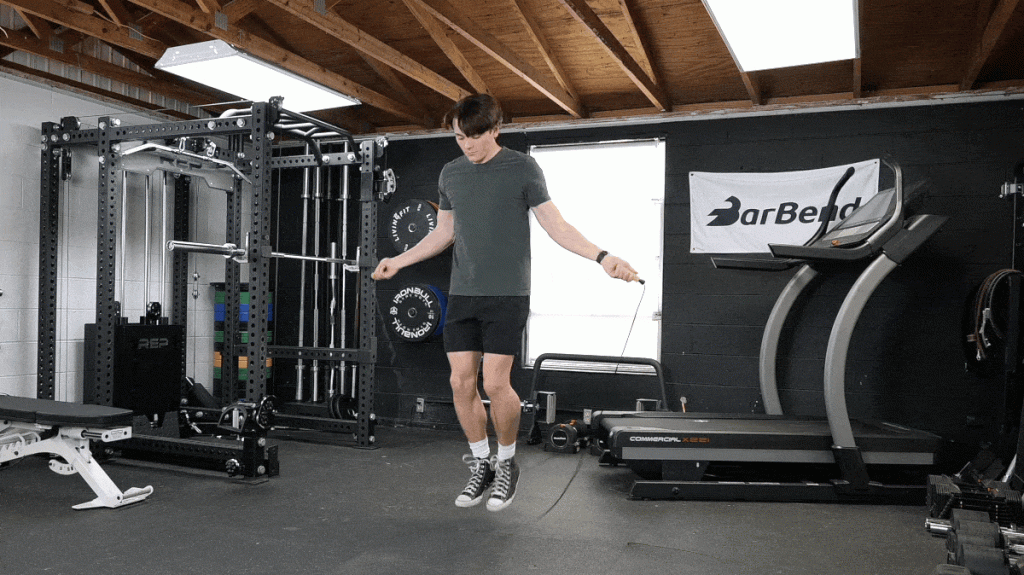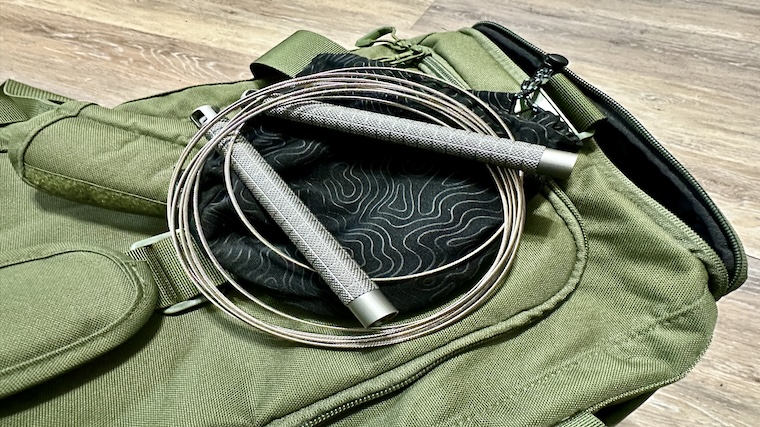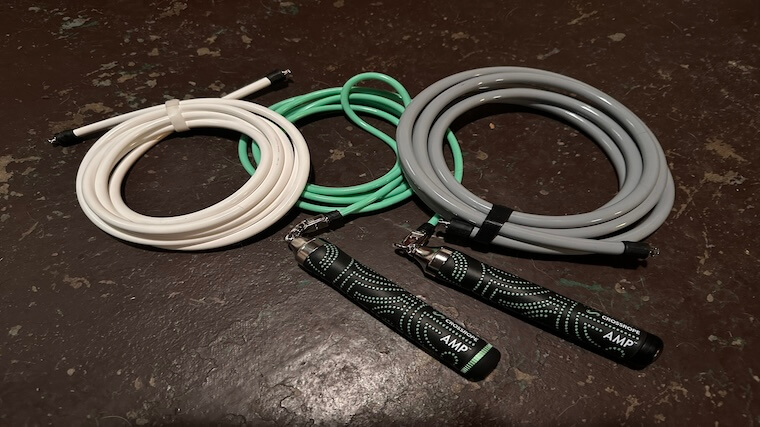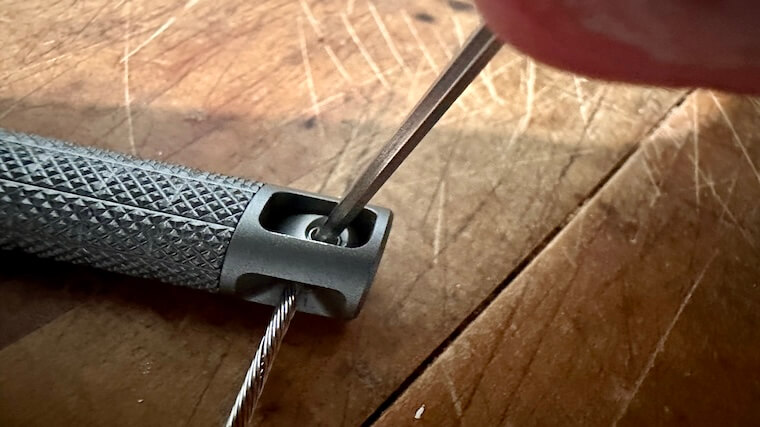Jumping rope is more than a kid’s game or a fancy way for nimble-footed athletes to show off. In fact, jumping rope can be a reliable way to improve your overall health, no matter your skill level. “Jump roping is fantastic, full-body exercise for those looking to elevate their heart rate and work up a sweat in a short amount of time,” adds BarBend expert reviewer Kate Meier, NASM-CPT, USAW-L1, CF-L1. “Even just 10 minutes of jump roping can burn around 100 calories, depending on your intensity.” (1)
Whether you’re seeking to improve your overall coordination or boost your cardiovascular health, incorporating one of the best jump ropes into your workouts can support these fitness goals. However, selecting the right type of jump rope for your needs — and making sure you have the right rope length — can be the difference between reaping these benefits and ending up crumpled on the floor. Continue reading as we walk you through a step-by-step process on how to measure a jump rope and why it’s so important to find your optimal rope length.
Measuring a Jump Rope
Jumping rope is among the best cardiovascular exercises one can do at home. Before you start jumping, though, you’ll want to make sure your rope is the proper length. “Too short of a rope means you’ll be whipping yourself in the legs entirely too often; too long of a rope means the rope will hit the ground way out in front of you, affecting your timing and likely causing you to miss your jump,” says BarBend expert reviewer Kate Meier.

If you are unable to purchase a jump rope that’s already the right length for your height — or you are using one on loan at the gym — then check out our step-by-step guide for properly measuring and adjusting a jump rope.
Step 1: Stand at the Midpoint
With the rope’s handles in both hands, step on the middle of the jump rope with your right foot, then your left foot, leaving about two inches of space between your feet.
Step 2: Pull The Rope To Your Chest
While standing on the rope, bring both handles of the rope up towards your chest. If they are at an even level, you are at the midpoint. If one of the handles is higher than the other, then you need to adjust your position on the rope.
Step 3: Raise Rope To Your Armpits
From your chest, raise the handles toward your armpits. Make sure the rope is pulled tightly to your armpits and remove any slack. Don’t use the top of the handles as the measuring point for this step — instead, you’ll want to see whether the base of both handles comes up to the bottom of each armpit.
[Related: Best CrossFit Equipment]
Step 4: Adjust Your Rope’s Length
“If the handles are lower than that, you need a longer rope. If they are above your shoulders, you should shorten your rope a little,” explains Meier. If it’s too long — and you don’t have the option to snag a smaller jump rope, you will need to adjust or trim it.
Step 5: Cut Excess Rope
If you are using an adjustable rope, then you can make the appropriate adjustments for the correct length. However, if you are using a non-adjustable rope, you will need to cut the excess rope. For cable ropes like speed ropes, you will need a wire cutter. For PVC or knitted ropes, you can use scissors.
Make sure you don’t cut the rope too short. Always leave about three to four inches of extra length just in case you incorrectly measured the rope. It’s better to leave extra length than to cut it too short since you can always repeat these steps if the rope is still too long. However, if the rope is too short, then you will have to buy a new one.
Jump Rope Sizing Chart
A general rule of thumb is that your jump rope should be roughly 3 feet longer than your height. So, if you are 6 feet tall (72 inches), then your jump rope should be 9 feet tall (108 inches).
| Height | Rope Length in Feet | Rope Length in Inches |
| 3’3”- 3’5” | 6’3”- 6’5” | 75 – 77 |
| 3’6”- 3’8” | 6’6”- 6’8” | 78 – 80 |
| 3’9”- 3’11” | 6’9”- 6’11” | 81 – 83 |
| 4’0”- 4’2” | 7’0”- 7’2” | 84 – 86 |
| 4’3”- 4’5” | 7’3”- 7’5” | 87 – 89 |
| 4’6”- 4’8” | 7’6”- 7’8” | 90 – 92 |
| 4’9”- 4’11” | 7’9”- 7’11” | 93 – 95 |
| 5’0”- 5’2” | 8’0”- 8’2” | 96 – 98 |
| 5’3”- 5’5” | 8’3”- 8’5” | 99 – 101 |
| 5’6”- 5’8” | 8’6”- 8’8” | 102 – 104 |
| 5’9”- 5’11” | 8’9”- 8’11” | 105 – 107 |
| 6’0”- 6’2” | 9’0”- 9’2” | 108 – 110 |
| 6’3”- 6’5” | 9’3”- 9’5” | 111 – 113 |
| 6’6”- 6’8” | 9’6”- 9’8” | 114 – 116 |
| 6’9”- 6’11” | 9’9”- 9’11” | 117 – 119 |
| 7’0” – 7’2” | 10’0” – 10’2” | 120 – 122 |
Why Jump Rope Length Matters
Jumping rope has many fantastic health and fitness benefits, from improving your cardio and balance fitness to building bone density, improving coordination, and burning calories. (2) “In general, I love prescribing any kind of jumps to my clients as they progress working through balance and coordination exercises,” says Meier. “Jumping rope is an excellent way to get the mind and body in sync. You have to concentrate on timing your jump as well as getting your upper body to coordinate with your lower body.”
However, if you don’t have a jump rope that’s the right length for you, then you not only hinder experiencing these benefits but you also increase the chances of injury.

For example, if your rope is too short, you’ll have to jump higher to clear it. Unfortunately, this makes it easier to trip over the rope and fall. In my years of working as a personal trainer, a short rope was the most common mistake I saw in gym-goers trying to jump rope. Apparently, these exercisers thought that any length rope would work. After a few faceplants, they quickly realized just how wrong they were.
It’s also worth noting that jumping higher over a shorter rope can increase fatigue and lead to injuries like shin splints and joint pain in the ankles or knees. Not only can a short rope throw your jumping mechanics off, but it can also increase the impact of any falls, as you’ll be jumping higher into the air.
If your rope is too long, then it can drag across the ground and potentially tear. Additionally, hitting or dragging a long rope across the ground can interrupt your pace and throw off your jumping mechanics.
A rope that’s too short or too long can also compromise your jump rope posture. As with any cardio exercise, proper form is key to maximizing the benefits of jumping rope. So, if the rope is too short or long, then your compromised posture could lead to poor technique.
Proper jump roping posture requires you to have your back straight, hips aligned, core activated, shoulder blades back, head up, eyes looking straight ahead, and elbows in. (2) If you find that your posture is being compromised, then measure your rope again to make sure it’s the right length.
[Related: Bodyweight Cardio Exercises]
Types of Jump Ropes
When it comes to jumping rope, you must first decide which rope is the right one for you. This decision could be based on several factors, like whether you’re jumping for fun or fitness. Once you have decided on a type of rope, you’ll want to make sure the rope is the right length for you. Let’s take a closer look at the different types of jump ropes and the benefits of each.
Knitted Jump Ropes
Knitted ropes are the “old school” jump ropes that you’ll see on many school playgrounds. You know, the ropes that we played double-dutch with or an intense battle of tug-of-war against our frenemies. Knitted ropes have evolved since the old days, and they tend not to fray as easily when dragged across pavement. In fact, some would classify beaded ropes as a type of knitted rope, since that’s the type of rope that’s holding the beads together.
Knitted jump ropes are great for children skipping rope with their friends or for a beginner workout plan.
Adjusting knitted ropes is as easy as tying your shoes. To adjust a knitted rope, just pull the rope through the handles and tie a knot at the appropriate length. For more advanced users, you can cut off the excess rope if desired, but make sure to test out the length of the rope a few times before trimming the excess. If you cut it too short, then you will need to buy a new rope.
Speed Ropes
Speed ropes are designed for fast jumping. In fact, they’re like the sprinting of jumping rope. These ropes consist of a super-thin cable and are very lightweight. The handles will have ball bearings in them to help spin the rope faster.

Speed ropes are ideal for CrossFit athletes, boxers, and advanced jumpers. When I was younger, I used to watch Mike Tyson AND Rocky Balboa training with speed ropes and performing tricks like double unders and side swings. I often tried to emulate their workouts, but after smacking myself in the face a few times, I learned that these ropes aren’t ideal for beginners. It takes time and practice to build up to this level.
Despite being an advanced training tool, adjusting speed ropes is an easy process. The handles have a screw that can be loosened to pull the rope through. Once you have adjusted the rope to your ideal length, just tighten the screw again. If needed, you can use wire cutters to trim the excess length after making your adjustments.
PVC Jump Ropes
PVC ropes are made out of a flexible, lightweight PVC cord. These ropes are ideal for beginners because they’re lighter than most other types of jump ropes but heavier than speed ropes. In fact, PVC ropes are great stepping stones to building up to speed ropes. PVC ropes are versatile in that you can do traditional rope training or speed training as well.
Most PVC ropes have a plastic clip located inside the handles. Release the clip to adjust the length of the rope and then push the clip back into place when you have your desired length. If needed, you can use a pair of scissors to cut any excess rope.
Weighted Jump Ropes
Weighted ropes are designed to increase the intensity of your workouts. These ropes are made out of thicker steel or PVC cables and have added weight in the handles. Weighted ropes can range from 0.5 to 6 pounds.
“As one of the best plyometric exercises, jumping rope can strengthen your muscles through building muscular power. You can take that benefit up a notch if you use a weighted jump rope,” notes Meier.

This extra weight will give your arms and shoulders more of a burn as you jump rope. However, weighted ropes are not for beginners. These ropes are ideal for advanced athletes who already have a solid foundation of jump rope experience. In the hands of beginners, weighted ropes can compromise form and potentially increase the chances of injury.
Typically, weight ropes can’t be adjusted, as the cable is too thick to cut and the handles aren’t adjustable. You must rely on the three-foot rule that we discussed above. However, some users try to get around this by tying knots near the handles if the cable length is too long.
Cordless Jump Ropes
Like jumbo shrimp, cordless ropes sound like an oxymoron. How does a jump rope without a cord work? Well, these types of jump ropes have weighted handles to simulate the turning of a rope. Cordless ropes tend to have 3- to 4-inch cords poking from each handle, but, in addition to being short, they’re not connected, so there’s no cord to trip over, drag on the ground, or smack yourself in the back of the head with.
They’re designed to improve one’s rope turning mechanics and form so you can make the most of cardio workouts at home. Although cordless ropes are beneficial to jumpers of all experience and fitness levels, they’re not meant to replace other ropes. Cordless ropes aim to identify issues with your grip, wrist-turning mechanics, and arm positioning.
You can adjust the length by pulling the cord through the handles for more or less length. These ropes will never need to be cut or trimmed.
How to Adjust a Jump Rope
Adjusting a jump rope really depends on which type of rope you are using. Some jump ropes require specific tools to trim the excess length. The following are three common methods for adjusting jump ropes.
Adjustable Handles
These days, manufacturers have made it easier to alter the length of your jump rope via adjustable handles. Typically, these handles can be modified to lengthen or shorten a rope.
On speed ropes, for example, the handles can be adjusted by loosening the screw and then pulling the rope through the handles to modify the length. Once you have your desired length, you can tighten the screws in the handles and lock the length in place.

PVC ropes can also have a locking and unlocking mechanism in the handles. However, instead of screws, PVC ropes have plastic clips that can be locked and unlocked to adjust a rope’s length.
[Related: How to Program Plyometric Jump Training Into Your Weightlifting Workouts]
Cutting The Rope
If your rope doesn’t have adjustable handles, you can always cut the excess length. For knitted or beaded ropes, you can use scissors to cut the excess length found after you measure the rope. For speed ropes — or other ropes made of thicker wire and cords — you will need wire cutters to trim the excess length.
Always make sure to measure your jump rope more than once, and to use them a few times before cutting. If you cut it too short, you will have to buy a new rope.
Tying The Knot
If you prefer not to cut, tying knots is a common method for adjusting a rope. After measuring your jump rope to find the proper length, you can tie knots at the end of the handles to lock in the adjusted length. Advanced users may also tie knots with weighted ropes since they’re made of thick cords that are too difficult to cut.
Final Word
Jumping rope has many wonderful health benefits for users of all fitness levels. However, it is important that you choose the right type of jump rope and make sure that it’s at the right length for your height.
Using a jump rope that’s too long or short can impede your workouts and increase the chances of injury. If you take the time to properly measure your rope and make any necessary adjustments to the length of your rope, then you can put yourself in the best position to accomplish your fitness goals.
How to Measure a Jump Rope FAQs
How do you measure the length of a jump rope?
Step on the middle of the rope with both feet about 2 to 3 inches apart. Pull the rope up to the middle of your chest to see if the rope handles are even. If one handle is lower than the other, then you will need to adjust where you are standing on the rope. Once the handles are even, bring them up to the lower portion of your armpits. If the end of the rope, just before the handles, doesn’t reach this mark, then the rope is too short. If the end of the rope goes higher than this point, then the rope is too long.
How long should a jump rope be for your height?
The general rule of thumb is that the rope should be 3 feet longer than your height. Since you are jumping rope with your shoes on, you should measure your height while wearing shoes. If you are 6 feet tall with shoes on, for example, then you will need a rope that measures 9 feet in length.
What tools do you need to adjust a jump rope?
Some jump ropes, like weighted ones, can’t be adjusted. If the length isn’t suitable to your height, you will have to buy a new one. However, the majority of jump ropes can be cut with either a pair of scissors or a wire cutter. For PVC ropes and speed ropes, you’ll want to cut excess rope with wire cutters. For knitted ropes and beaded ropes, a pair of scissors can be used to trim the excess length.
References
- Harvard Health Publishing. (2021, March 8). Calories burned in 30 minutes for people of three different weights. https://www.health.harvard.edu/diet-and-weight-loss/calories-burned-in-30-minutes-for-people-of-three-different-weights
- Cleveland Clinic. (2024, January 16). Hop to It: 6 Benefits of Jumping Rope. https://health.clevelandclinic.org/jump-rope-benefits